|
Table of Contents |
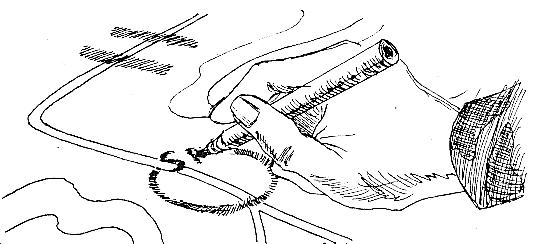
Effective employment of obstacles is a key element in any tactical plan. Obstacles that are sited properly provide the commander a significant advantage in both the offense and defense. Planning and emplacing obstacles cannot be approached haphazardly. The obstacle planning process must be systematic, coordinated, and fully integrated with the tactical plan. The logistic demands of obstacle employment must also be planned for and available at the proper place and time. All elements of the combined arms team must be involved in the obstacle planning and employment process in order to extract the greatest cost from the enemy. This chapter outlines the sequence and basic considerations for planning and coordinating countermobility activities in various operations.
OFFENSIVE PLANNING CONSIDERATIONS
DEFENSIVE PLANNING CONSIDERATIONS
RETROGRADE PLANNING CONSIDERATIONS
Obstacle planning is serious business, and involves all elements of the combined arms team. Obstacles must support present and future tactical plans, be logistically supportable, and fully coordinated. Some important factors to be considered are listed below.
The mission is the primary consideration in obstacle planning. The employment of obstacles in support of a DEFEND mission would be significantly different from obstacle employment in support of a DELAY or an offensive mission. The obstacle plan should be tailored to support the mission of the organization and accomplish the objectives of the command.
Directed and reserve obstacles are of prime importance to the overall mission and should be planned first. Authority and time of execution must be known.
While obstacle employment is supporting the current mission, it should not impede future plans or missions. This may not be completely possible in every instance. Emplacing an artillery delivered minefield upon an attacking enemy may be the right thing to do, even though an attack through the area was planned prior to self-destruction of the minefield. Pros and cons must both be considered.
The obstacle plan should exploit the weaknesses of the enemy. If the enemy is short of rapid bridging capability, a tank ditch may be a more effective obstacle than a minefield. If the enemy is low on diesel fuel or ammunition, attacking their trains and supply lines may be the most effective use of obstacles such as scatterable mines.
These factors and their effects are critical in answering the following questions: Where are good existing obstacles? Are they within the enemy's avenue of approach? Are they effective when tied in with reinforcing obstacles? Are they within range and fields of fire of friendly weapons? What are the anticipated weather conditions? Is the soil frozen? Is digging possible? Can mines be buried?
Answers to these questions will dictate to a large degree the type and extent of the obstacle system, and also provide information on additional resources required and task organization. How much time is available to spend on battlefield preparation? Have the required materials been ordered? Are they on hand? Is the manpower available for labor-intensive obstacles? Is earthmoving equipment available for tank ditches and other equipment-intensive obstacles? Has the high diesel fuel consumption rate been planned for?
Cultural features are not destroyed unless the mission makes it absolutely necessary. These considerations are not inclusive. There may be many other important factors. Each mission, operation, or battle phase will pose distinct requirements that must be considered and planned for. Obstacles can be the difference between winning and losing. Their employment must be carefully planned and fully coordinated.
Obstacles should be emplaced according to these general guidelines:
Developing an obstacle plan that is effective and supports the tactical plan requires coordinated sequential planning. The following sequence should be used to develop such an obstacle plan. This sequence is equally effective in both offensive and defensive operations.
1 Analyze the mission.
2 Analyze avenues of approach.
3 Analyze engagement areas, battle positions, and locations of weapon systems.
4 Determine possible obstacle locations and types.
5 Determine the commander's obstacle priorities.
6 Determine resources.
7 Determine actual work sequence.
8 Determine task organization required.
9 Determine coordination required.
1 Analyze the mission. The mission is a clear, concise statement and purpose of the task to be accomplished by the command. It tells the command the "who," "what," "where," and "when" of an operation. Analysis of the mission is a critical item in planning obstacles. The "who" portion and accompanying task organization allocates resources to do the job. The "what" specifies the type operation such as "defend," "attack," or "delay." "Where" outlines the area of operations, and "when" specifies the time available and essentially establishes deadlines. During the planning phase, much or all of this information will be verbal based upon commander and staff analysis of the mission received from higher headquarters. The estimate, eventual plan, and execution are based upon tasks contained in the mission.
2 Analyze avenues of approach. Once the mission has been received and analyzed and the basic objectives are known, the next step in obstacle planning is to determine avenues of approach. Terrain analysis techniques and existing obstacle evaluation, as described in chapter 2, are performed. The commander must visualize the avenues of approach under all conditions, and determine the size of friendly or enemy forces those avenues can support.
3 Analyze engagement areas, battle positions, and locations of weapon systems. A good terrain analysis will show where the best areas are for friendly weapons to engage the enemy. In offensive planning, the most likely areas where friendly forces could expect to be engaged by enemy direct fire weapons can also be ascertained. The analysis process is essentially the same in both the defense and the offense. Analysis of existing obstacle areas, fields of fire, and natural cover and concealment are key factors in determining where to best engage the enemy or expect to be engaged.
4 Determine possible obstacle locations and types. Selection of engagement areas and battle positions must be accomplished prior to planning reinforcing obstacles. Once the commander has selected engagement areas and battle positions, then the commander and the engineer select those reinforcing obstacles that accomplish the basic principles. This selection process is unconstrained, meaning that the commander and engineer will select and site all the reinforcing obstacles necessary without regard for manpower, time, and logistics. This selection process will determine what "needs" to be done in order for the obstacle system to be most effective. What "needs" to be done will usually require more effort than resources available. The process provides the commander and the engineer with a method to establish priorities if resources are constrained.
5 Determine the commander's obstacle priorities. Once the unconstrained obstacle estimate has been accomplished, the commander can establish priorities for obstacles. By seeing what "needs" to be done, the commander can choose those obstacles that must be emplaced. Through this process, the engineer is given direction to employ resources knowing the effort is expended on those obstacles most critical for accomplishing the command's objectives. The type, proposed location, and purpose of the obstacles will depend on an offensive or defensive plan. However, the basic thought process remains constant.
6 Determine resources. The commander and the engineer consider the assets available to construct, guard, and execute the obstacle plan. Engineer assets are limited, and the priority of work maybe given to only a portion of the planned area of operations. The engineer takes the commander's priorities and makes an estimate based upon time, manpower, equipment, and logistics. The engineer must know how much of each resource is required to emplace and execute a given obstacle. This estimate is based upon type of obstacle, soldier experience, state of training, and condition of equipment. Standard obstacles (appendix D) may be used to assist in the estimating process. They are only a guide and should be altered according to existing conditions at the time of the estimate.
Another factor in the engineer estimate is the commander's decision on who will guard and detonate preliminary demolition obstacles not detonated immediately after emplacement. Essentially, the commander has two choices--either use engineer soldiers, or soldiers from maneuver units. If engineers are used, then engineer assets are used up quickly, thus limiting the number of obstacles that can be emplaced as the battle progresses. The same can be said for using maneuver units to guard and detonate obstacles. This difficult decision must be made early enough for the engineers and maneuver units to properly plan. In any case, the target turnover process must be trained and rehearsed during combined arms training so the commander has some latitude in decision making.
The time available to accomplish the obstacle mission is an important consideration. Lead time is required to gain sufficient obstacle density to obtain tangible benefits from the obstacle plan. Emplacement time will vary with the types of obstacles. For example, it may take more manhours to emplace a conventional tactical minefield than to emplace a road crater or prepare a bridge for demolition. Emplacement lead time is divided into two parts: time required to actually construct the obstacle, and time required to get materials to the obstacle location. The latter may require twice as much time as actual obstacle construction. The loss in productivity due to logistics time can be reduced by allocating additional transportation support to engineer units. In most cases, the engineer squad's truck or APC must serve as both personnel carrier (mobility) and cargo carrier (resupply). Another way to increase production is to work maximum hours, but this pace can be maintained for only a few days before soldiers and equipment begin to fail.
Finally, logistical matters must be considered. The commander must set priorities for the delivery of munitions and material, and must allocate the available haul assets among ammunition, obstacle materials, and other critical supplies. Among obstacle materials, difficult choices must be made. A conventional tactical minefield can take up to a hundred times the haul assets of a point obstacle, yet the minefield may be the only effective obstacle in the situation. To minimize the haul requirements, the engineer must make imaginative use of locally available material. Alternative obstacles should also be considered. Frequently, tank ditches can be substituted for a minefield, using engineer equipment that is available and not in use, instead of placing an additional demand on an overloaded transportation system.
7 Determine actual work sequence. The commander and the engineer now must reconsider the possible obstacles identified earlier. Considering the time available, work force, and logistical assets, they identify those obstacles which can realistically be completed within the allotted time. They also identify obstacle work which may continue during the battle.
The commander's obstacle plan will usually develop through the answers to such questions as:
8 Determine task organization required. The tactical commander and the engineer must balance the comprehensiveness of the obstacle plan with the realities of limited assets. For example, a task force commander's sector may be critical and in need of intensive engineer work in order to complete the plan. The brigade commander, on the other hand, may anticipate that the primary threat will develop in another task force sector. Accordingly, the brigade commander may allocate fewer engineers than desired by the task force commander. The engineer recommends the allocation of engineer units to best support the brigade commander's coordinated obstacle plan. Additional engineer units, if available, may be obtained by coordination with the division engineer and the division commander. These units may come from the organic engineer battalion or corps assets.
9 Determine coordination required. Obstacle planning and employment requires extensive coordination to accomplish its purpose. The G-4/S-4 must receive a materials estimate as early as possible in order to plan logistic support of the obstacle system.
The artillery fire support coordinator, aviation officer, and air liaison officer must also be consulted to integrate scatterable mines with the obstacle system. Missions which require scatterable mines are planned in detail to include the location, the unit delivering the mines, and necessary logistic support. Coordination and responsibilities for scatterable mine employment are outlined in chapter 5.
Obstacles must also be coordinated with follow-on and adjacent units to insure that the location and extent of the obstacle system are known. This coordination will preclude the obstacle impeding movement and maneuver of friendly forces. If followed, this planning sequence is a workable, realistic, and coordinated approach to planning obstacle employment. It will insure that the result is a coordinated and executable plan that extracts the greatest cost from the enemy.
In the offense, the priority of the engineer effort is to maintain friendly force mobility. Countermobility activities are also important to halt or slow the enemy's counterattack capability and isolate the battlefield. Such operations assist friendly forces in defeating the enemy in detail. Countermobility operations can be employed in all types of offensive operations. Obstacles and mine warfare in offensive operations have three main purposes:
1 Prevent enemy enforcement.
2 Facilitate economy of force.
3 Provide security.
1 Prevent enemy reinforcement. Offensive operations are conducted to exploit enemy weaknesses. To prevent the enemy from reinforcing weak areas under friendly attack, critical routes should be interdicted to hinder movement of reserves and logistics. Speed and deep interdiction capabilities are vital, Air-delivered scatterable mines are ideally suited for this mission.
2 Facilitate economy of force. Obstacles and mines can be utilized in selected sectors to allow defense by reduced forces. Relieved maneuver units can then be concentrated in other sectors for the attack. Under other circumstances, easily defended terrain which is reinforced with obstacles and on-call scatterable mines may permit major sectors to be held by a relatively small force. Operations of this type are conducted by armored cavalry units with a screen or a protection mission.
3 Provide security. In offensive operations, mines and obstacles may be emplaced along the flanks of advancing forces in critical areas to halt or slow enemy counterattacks. In planning offensive operations, avenues of approach offering natural flank protection--such as a river or a ridge line--should be carefully evaluated. During the advance, it may be possible to protect a flank by destroying all bridges crossing a river, or by interdicting all roads and trails crossing a ridge line. Swamps, canals, lakes, forests, and escarpments are natural terrain features that can be quickly reinforced for flank security.
During offensive operations, engineer countermobility plans must permit rapid emplacement and flexibility. Time and resources will not permit development of the terrain's total defensive potential. Based upon likely enemy reaction, the most probable counterattack avenues should be closed off with obstacles. Plans should be developed for other possibilities and resources committed when the enemy response becomes apparent. Scatterable mines are excellent for this purpose. Aircraft and artillery delivered scatterable mines could be preplanned on each of several available routes. The mines should be delivered in front of, on top of, or on the flanks of the lead elements of an enemy counterattack after the enemy has committed itself to one of the routes. Rapid cratering devices are another excellent capability.
Speed of countermobility operations is vital and cannot be overemphasized. Engineer support must keep up the pace and emplace obstacles and mines along with advancing maneuver forces. Effort for countermobility during offensive operations must be carefully weighed against the mobility requirements to support the advance. Resources must be planned and used wisely. Under ideal circumstances, plans should be flexible for engineer forces to perform both mobility and countermobility operations as the tactical battlefield situation requires.
Control of mines and obstacles, and accurate reporting to all units are vital. An obstacle or mine in place will hinder either friendly or enemy maneuver. Positive command and control is necessary to insure that minefield and obstacles are not executed until desired. Once executed, they must be reported by the executing unit through operation channels and posted to operational and intelligence maps. Information on obstacles and minefield in place is disseminated with tactical intelligence. The recording and reporting procedures for scatterable mines must be rigidly followed. These procedures are discussed in chapter 5. Key factors for countermobility activities during offensive operations are:
Defensive operations achieve one or more of the following:
The immediate purpose of any defense is to cause an enemy attack to fail. The other reasons listed contribute to purposes beyond the immediate defense.
It may be necessary to gain time for reinforcements to arrive or to economize forces in one sector while concentrating forces for attack in another. In either case, a defense or a delay may achieve these purposes.
In some cases, a force may be defending because it cannot attack. The defender then takes advantage of position and superior knowledge of the terrain. Once the enemy has been committed to the defense and weakened by losses, friendly forces maneuver to destroy the enemy with fires or counterattacks. In other cases, portions of a force may be required to retain key terrain or essential tactical, strategic, or political objectives.
In some instances, these must be first seized by airmobile or airborne forces, and then held until a larger force can link with the defender. An underlying purpose of all defensive operations is to create the opportunity to change to the offensive. All activities of the defense must contribute to that aim.
The defense has been called the stronger form of war because denying success to the enemy is easier than forcing the enemy to do our will. The defender has significant advantages over the attacker. In most cases, the ground is better known, and the defender occupies first and therefore becomes stronger as positions improve and forces mass. Once the battle begins, the defender fights from cover against a more exposed enemy, and uses the terrain to mask movements as forces gather to block and attack the enemy. Finally, the defender can postpone commitment of major forces until the attack has developed, and then strike the extended enemy over carefully selected and prepared terrain within the defensive area. The effects of obstacles, airpower, and conventional weapons on exposed troops, and certain aspects of nuclear, chemical, and electronic warfare, also favor the defender.
Balanced against the defender's advantages, however, is the attacker's single greatest asset--possession of the initiative. The attacker takes advantage of the opportunities to concentrate first and surprise the defender by chosing ground, direction of approach, and time of attack. Also, this initial advantage is used to mislead or distract the defender, slow recognition of the main attack, and delay implementation of countermeasures. The defender's ultimate task is to overcome the attacker's initial advantages and quickly regain the initiative.
Napoleon summarized the requirements of defensive campaigns when he said in his Memoirs: "The whole art of war consists in a well-reasoned and extremely circumspect defensive, followed by rapid and audacious attack."
The key terms of AirLand Battle doctrine--initiative, depth, agility, and sychronization--also outline the requirements for a successful defense at any level.
Seize the tactical initiative locally, then generally, as the battle progresses.
Fight the enemy throughout the depth of its formations to delay and disorganize, and to create opportunities for offensive action. The defender must organize forces and resources in depth to gain the time and space required for flexibility and responsive maneuver.
Set the terms of battle through flexible use of fire, maneuver, and electronic warfare. Just as the attacker is committed to an action, the defender changes the situation and thereby forces a different countermove. This overloads the enemy's command and control system and renders his reaction uncoordinated and indecisive. Effective use of agility can lead to the enemy's piecemeal destruction.
Synchronize all available tools of battle in. well coordinated combat actions. Violent execution of plans and aggressive exploitation of enemy vulnerabilities can halt the attacking force's momentum.
Initially, the defender will be outnumbered. In the early stages of the battle, the defender must capitalize on the advantage of fighting from stationary, protected positions to halt the enemy. Deep attack on the enemy, the actions of security forces, and detailed fire and obstacle plans facilitate containment of the attack.
Once the attacker has been controlled and the defender has concentrated forces in the area of the main attack, the defender can then operate against exposed and precisely located segments of the attacking force. Then, by being under the cover of his own field artillery, air defense, and on ground he has reconnoitered and prepared, the defender has the advantage. Once the attacker has extended into the defended area, he is vulnerable to fires from all sides, surprise attacks on flanks and rear, and loss of the initiative.
To succeed, the attacker must shatter the defense quickly and maintain a high pace of operations to prevent its reconstitution. To defeat the attacker, the defender must protract operations, keep the tempo slow enough to allow reaction, and, ultimately, isolate and destroy attacking forces.
The attacker cannot be allowed to focus full strength at one time and place on the battlefield before defensive countermeasures have been prepared. This can be accomplished through skillful use of terrain and by interdiction of following forces through deep attack. The attacker's ability to sustain the momentum of the attack and set the pace of battle must be broken. This will occur if it is difficult to employ fire support assets, reinforce, resupply, and direct attacking echelons.
The attacker must be required to divert energies and efforts into nonproductive ventures and to strike at nonexistent targets through deception, operations security, and maneuver. This dissipates strength and uses resources.
Karl von Clausewitz characterized the ideal defense as a "shield of blows." At the onset, the defender yields the initiative to the attacker. However, the defender has the advantages of prepared positioning and better ground knowledge, and uses them to slow the momentum of the attack and repeatedly strike the enemy. In defeating the attackers' combined arms coordination, strength, and concentration, the defender destroys the attacking force with effective maneuver supported by flexible firepower. It is not necessary to kill every enemy tank, squad, or combat system, but only to destroy the ability to continue fighting.
United States Army defensive doctrine is designed to be applicable anywhere in the world. The form of defense the commander chooses will depend on the mission, nature of the enemy, terrain possibilities, and capabilities of available units. The commander may elect to defend well forward or in considerable depth, if not required to hold a specified area or position. The commander may even choose to preempt the enemy with spoiling attacks if conditions favor such tactics. Depending on the depth available, forces at hand, and the mission, the commander may defend by striking the enemy as it approaches. The commander fights the decisive battle within the main battle area, or draws the enemy deep into the area of operations, and then strikes along enemy flanks and rear. All three methods have been used in the past with decisive results.
Corps and divisions fight a unified defensive AirLand Battle within an organizational framework consisting of five elements:
1 The deep battle.
2 Covering force.
3 Main battle area.
4 Rear battle.
5 Reserve operations.
The deep battle, the covering force battle, and the main battle area (MBA) battle are planned as complementary actions which support a unified battle plan. The overall commander delineates areas of interest and influence, the covering force area (CFA), the forward edge of the battle area (FEBA), the rear line of the MBA, and the rear area. The forward line of own troops (FLOT) is initially defined by elements of the covering force. After contact with the enemy, FLOT generally defines the line of contact throughout the battle. The commander also establishes an initial ilre support coordination line (FSCL) and any blocking positions, strongpoints, stay-behind forces, or phase lines necessary for executing the plan. The commander decides whether to fight a forward defense or a defense in depth. The commander organizes the overall defensive effort on the basis of the mission, the nature of the enemy force, the terrain, the troops assigned, and the time available. The commander allocates forces and resources within the elements of the organizational framework to support the overall scheme.
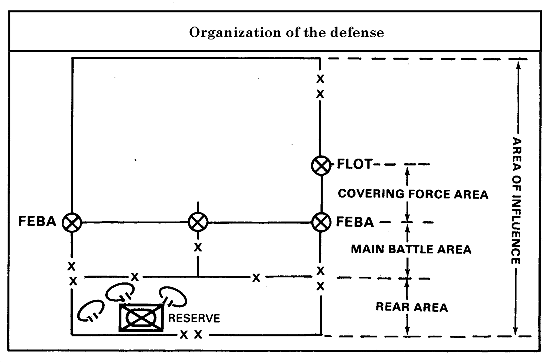
1 The deep battle. The deep battle component of the AirLand Battle is designed to support the commander's basic scheme of maneuver by disrupting enemy forces in depth. Its goal is to create opportunities for offensive action against committed enemy forces by delaying the arrival of enemy reserves or follow-on forces, or by destroying key enemy, organizations. Surveillance operations are conducted to identify significant enemy forces in the area of interest while electronic warfare, long-range fire, and maneuver in depth are used to attack enemy forces whose delay or disruption is important to the success of the commander's plan. In the defense, the deep battle aims to prevent the enemy from concentrating overwhelming combat power. Main objectives are the separation and disruption of attacking echelons, protection of friendly maneuver and degradation of the enemy's fire support, command and control systems, combat and combat service support.
Engineer plans in support of the deep battle will resemble the support given any other offensive operation. Emphasis will be upon speed for ground forces. First priority of engineer effort will be mobility of the maneuver force. Countermobility, in terms of flank security and prevention of counterattack, is the second priority for engineers. Obstacles will, of necessity, be those that can be installed rapidly, such as scatterable mines and road craters. Scatterable mines will be a significant contributor to success of the deep battle. Targets and delivery means must be carefully chosen.
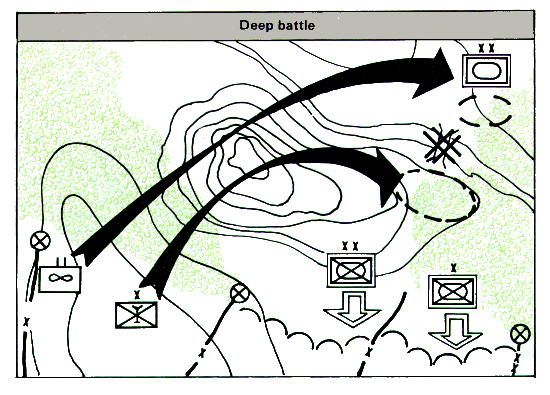
2 Covering force. The covering force generally has three basic tasks to accomplish:
In the covering force area (CFA), countermobility activities are primarily designed to disorganize enemy movement and enhance friendly fires. The density of obstacles in the CFA will be less than the MBA due to lack of time, depth of the area, and smaller numbers of engaged friendly forces. Siting obstacles will be extremely important. Manpower and equipment-intensive obstacles will not generally be emplaced in the CFA. The commander must make decisions on the amount of limited resources able to be committed to the CFA. Emplacement of obstacles in the CFA and the MBA will be occurring at the same time and competing for the same resources.
Time is a critical factor to consider in planning the battlefield preparation of the CFA. There will be little time for obstacle employment once the enemy attacks. Scatterable mines and quick demolition point targets, such as prechambered road craters, are ideal for use in the CFA. Obstacles should assist the covering force commander by accomplishing the following:
The majority of the engineer effort in the CFA will be accomplished by divisional and corps combat battalions. Selection of the proper command or support relationships will be critical due to the rapidity of the battle.
3 Main battle area. The main battle area (MBA) is bounded by corps-designated coordination points that establish the forward edge of the battle area (FEBA) and division-designated rear boundaries of the forward defending brigades. It is anticipated that the decisive battle will be fought by the forward committed brigades in this area. Therefore, the bulk of the defending force is deployed in the MBA. They are prepared to concentrate where necessary to defeat the enemy's main thrust. For control purposes, the MBA is subdivided by division, brigade, and task force boundaries. It contains a multitude of predetermined (and in some cases, prepared) battle positions from which the battle will be fought. The use of battle positions facilitates control of the combat elements during the flow of battle. They allow the commander to concentrate forces in critical areas with minimal confusion. The use of obstacles in the MBA is the key to gaining time for the commander to concentrate forces by slowing the enemy rate of advance. Existing obstacles will place certain restrictions on enemy maneuver and speed. To complement this, reinforcing obstacles are sited to--
Most of the obstacle effort is concentrated in the MBA. In addition to the divisional units, corps combat engineer battalions will be available to work in the MBA. Elements of corps combat heavy engineer battalions will be employed in MBA on a task basis.
4 Rear battle. The rear area is organized to provide for efficient combat service activities. Because most combat forces are forward, support elements must be trained and prepared for self-defense. Obstacles in the rear area are usually limited to protective minefield and command priority point obstacles. These obstacles will normally be concentrated in areas that could be used by the enemy as helicopter landing zones or drop zones for airborne forces. Scatterable mines, especially antipersonnel mines, could be used on targets of opportunity in the rear area. The rear battle commander will be competing with maneuver forces for scarce countermobility resources. The overall commander will establish priorities for effort and expenditure of materials throughout the depth of the battlefield.
5 Reserve operations. The reserve force, regardless of size, will require engineer support in order to accomplish its mission of counterattack, defensive reinforcement, or reaction to a rear area threat. If the reserve force is primarily made up of aviation assets, then the engineer support required will be significantly reduced. Engineers supporting the reserve force can possibly be employed in the MBA with anon-order mission to support the reserve force. This method requires timing and mobility if the engineer unit is to join up and deploy with the reserve force. Engineer forces can also be located with the reserve force to provide survivability and countermobility support. This insures the unit will remain intact and capable of performing its mission.
A retrograde operation is an organized movement toward the rear or away from the enemy. It may be forced or voluntary, but must be approved by the appropriate higher commander. Forces conduct retrograde operations to harass, exhaust, resist, delay, and damage the enemy. Such operations gain time, avoid combat under unfavorable conditions, or draw the enemy into unfavorable positions. They are also useful in maneuver to reposition forces, shorten lines of communications, or permit the use of a force elsewhere.
The three types of retrograde actions are delays, withdrawals, and retirements. In delays, units give up space to gain time. They do not lose freedom to maneuver, and they inflict the greatest possible punishment on the enemy. In withdrawals, all or part of a deployed force voluntarily disengages from the enemy to free itself for a new mission. Withdrawals may occur with or without enemy pressure and assistance by other units.
In retirements, a force not in contact with the enemy conducts an administrative movement to the rear.
All retrograde operations are difficult, and delays and withdrawals are inherently risky. To succeed, they must be well organized and executed.
Delaying operations occur when forces are insufficient to attack or defend, and when the defensive plan calls for drawing the attacker into an unfavorable situation. These operations normally gain time to--
Delays gain time by forcing the enemy to concentrate repeatedly against successive battle positions. As enemy units begin to deploy for the attack, the delaying force withdraws to new battle positions. The enemy must repeat the same time-consuming deployment at the next position. At the same time, deep attack slows the enemy's advance and prevents him from massing overwhelming combat power against the delaying force. A delaying force must--
A delaying force can--
Although the delaying force will likely be outnumbered, it must seize the initiative whenever possible to conceal a weakness or disrupt enemy plans. To provide the required time, units with a delay mission may attack, defend, screen, ambush, raid, or feint. A commander who is delaying may defend initially and then shift to the delay only after the enemy has concentrated overwhelming combat power against initial positions. The commander then gains time by occupying succeeding battle positions and conducting short counterattacks until space runs out. If space is limited, the commander may have to accept greater risks to accomplish the mission. A commander's orders may require delaying the enemy forward of a certain line until a certain time. To do so, the commander would have to accept a decisive engagement.
Cavalry units train and organize especially for delaying operations. When available, they should execute the delay.
Delay from successive positions occurs when the sector is so wide that available forces cannot occupy more than a single tier of positions. Maneuver units continuously delay on and between positions throughout their sectors. This method is simple to control. Delay from successive positions is useful in less dangerous sectors, but is easier to penetrate than a delay from alternate positions because the force has less depth and time to prepare.
Delay from alternate positions involves two maneuver units in a single sector. While the first is fighting, the second occupies the next position in depth and prepares to assume responsibility for the operation. The first force disengages and passes through or around the second force. It then prepares to resume the delay from a position in greater depth, while the second force takes up the fight. Delay from alternate positions is useful in particularly dangerous avenues. This method offers greater security than delay from successive positions, but requires more forces, continuous coordination of fire and manuever, and is less certain to maintain contact with the enemy.
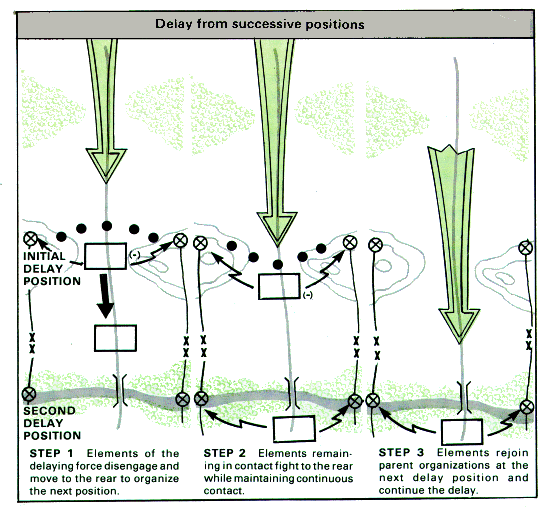
As the enemy's main effort becomes clear, commanders may add forces to threatened sectors and withdraw them from uncontested areas. But any delay maneuver must be alert for opportunities to damage the enemy with short, sharp offensive actions. Such actions keep the enemy on guard and lengthen the delay.
Orders
The time available determines the extent of preparations. It is not always possible to complete preparations before the delay starts. Consequently, commanders prepare continuously and adapt plans as situations develop.
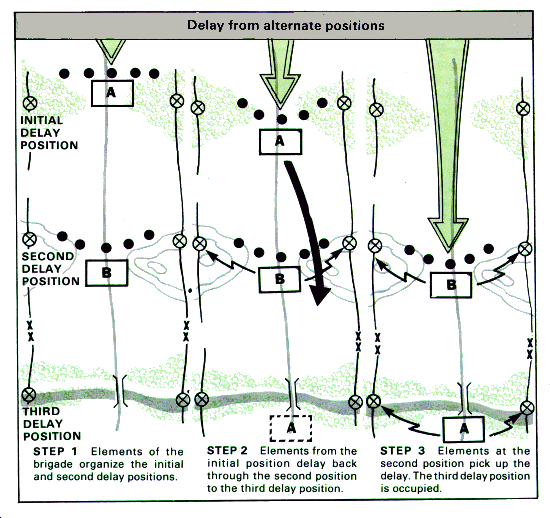
The order for the delay outlines the entire operation and describes its initial phase in detail. The commander issues supplementary orders during the battle to adjust and coordinate the delay. Missions assigned to subordinate elements and their sequence of execution are often more restrictive than other types of operations. Sufficient initial guidance will permit a subordinate commander to fight effectively even if contact is lost with the commander. Each subordinate commander, however, needs enough freedom to exploit any advantage which may develop.
Planning
The delaying force commander usually organizes the operation by identifying delay positions in depth throughout the area of responsibility. These positions normally follow natural lines of defensible terrain across the sector. Times may be assigned to delay positions indicating the minimum acceptable delay in each area. Commanders must carefully weigh the implied risks when imposing time limits on the delay.
Because sectors in a delay are usually wide, commanders must organize maneuver forces for independent operations. Every subordinate delaying force commander must understand the tasks and restrictions. Artillery and engineer support will usually be provided to the battalion or squadron level. Attack helicopter units are also valuable reserves in a delay because they are fast and effective against tanks.
The commander plans for offensive action as part of the basic delaying maneuver, and assigns responsibility to specific units for contemplated counterattacks. Unless reserves are prepared to strike, and preliminary plans for air, artillery, and engineer support are ready, the delaying force will miss opportunities.
The dynamic nature of the delay places a premium on the commander's ability to stay abreast of the situation and understand the options as the operation progresses. Each commander must be aggressive in obtaining and reporting information. Even during active combat, staffs must actively seek information and immediately report essential information to the commander. Division and corps commanders must pass gathered information to the delaying unit.
Commanders must know the status and location of their own units, flanking units, and enemy units. To enhance coordination, each commander will use prominent terrain features, redundant communications, rehearsals, simple maneuver schemes, and liaison parties. Wide frontages and multiple attacks will make it impossible for the commander to be present at every significant action. The intensity of combat will limit mobility, the condition of forces, and logistic posture. The obstacle plan must be known well enough to control the operation. Commanders must closely monitor and control radio communications during the delay. They should use wire communications between command posts, to reserves, and to delay positions that are particularly important. They should also set up dummy stations to deceive the enemy regarding strength and missions.
Divisions and smaller units delay from successive positions, delay from alternate positions, or a combination of both. At least a portion of the delaying force maintains constant contact with the enemy. Long-range fire, maneuver, and direct fire cause the enemy to deploy, reconnoiter, maneuver, or even halt. Nuclear or chemical fires, and short, violent counterattacks or ambushes disorganize and inflict casualties on him. Spoiling attacks as the enemy prepares to attack can also substantially delay his advance.
Effective use of obstacles will be a key element in executing a successful delay. Regardless of the type delay tactics used, obstacles enable the commander to effectively trade space for time. Obstacles which can be rapidly emplaced such as scatterable mines, bridge destruction, and road craters, are ideal to support the delay. Timely and proper placement of obstacles enable a commander to break contact, utilize economy of force, and provide valuable time to forces preparing the primary defensive area. Obstacles also weaken the enemy and his use of breaching assets, and cause him to be more vulnerable when encountering the main defensive area.
Beginning the delay
If no enemy contact occurs, reconnaissance forces will aggressively seek it on a wide front. They will repel enemy reconnaissance forces and determine the direction of enemy movement. At this point the delay begins.
A delaying force maintains continuous contact with the enemy, but avoids a decisive engagement unless the mission demands it. The delaying operation, which requires careful planning, should resemble a dynamic defense, yet it must be flexible enough to adjust to enemy maneuver. When the enemy discovers he is facing a delay, he will normally attempt to close and to penetrate. Early intelligence of enemy movements permits the defense to adjust, and also minimizes enemy success.
Maintaining control and coherence
Control and security during a delay derives from planning. The commander must insure continued coherence by--
Contesting the initiative
A successful delay requires commanders to take the initiative whenever possible, throwing the enemy off stride and disorganizing him with--
Concluding the delay
The delay can be concluded under several conditions, most probably when enemy forces have halted the attack or when the delaying force has achieved its mission and passed through another force. If the attacking force has halted because of attrition or logistic considerations, the commander of a delaying force can withdraw for another mission or maintain contact. The higher commander may choose to attack through a delaying force. In this kind of operation, timing for such an attack is usually critical. To facilitate it, the delaying force must assist in the forward passage of lines and provide knowledge of the enemy and terrain.
Passing lines under pressure
If the delaying force withdraws through a defending force, it must pass through lines to the rear and hand off the battle to the defending force. The success of the delay's final stage requires--
Passage of lines is especially difficult in limited visibility. Transition should therefore occur just forward of the new defense in such a way that location and organization are not revealed.
In many instances, it will be preferable to pass delaying units to the rear in sectors not under direct attack. Commanders may do so by maneuvering delay forces away from the enemy's front just before it reaches the main defense. If the delaying force can lead an aggressive enemy into the defense, it can cause heavy damage.
When the commander finds it necessary to reposition all or a part of the force, a withdrawal is conducted. The deployed force voluntarily disengages from the enemy. The operation may occur with or without enemy pressure and assistance by other units.
Without enemy pressure, withdrawing requires effective security and depends primarily on speed and deception. Stealth or a nuclear or ground attack may be necessary to divert the enemy's attention. Commanders must have contingency plans in case the enemy detects the withdrawal and attacks. Successful withdrawals normally occur at night or during poor visibility conditions. They also occur in difficult terrain under friendly air superiority, even though poor visibility and difficult terrain complicate friendly control. Smoke and concealed routes can reduce the enemy's ability to observe friendly movements, but commanders must anticipate enemy interference by fires and maneuver in depth.
Under enemy pressure, withdrawing depends on maneuver, firepower, and control. All available fires, perhaps even nuclear fires, support the withdrawal of closely engaged friendly forces. Forward elements move to the rear by aggressive small-unit delaying tactics. Rearward movement must be tightly coordinated and controlled.
When simultaneous withdrawal is not practicable, the commander must determine an order of withdrawal. If the most heavily engaged units are withdrawn from the areas of greatest enemy pressure first, the enemy may encircle or destroy major elements of the command. If the least heavily engaged units are withdrawn first, all or a major portion of the most heavily engaged units may be lost. Commanders must decide what action best preserves force integrity while accomplishing the mission.
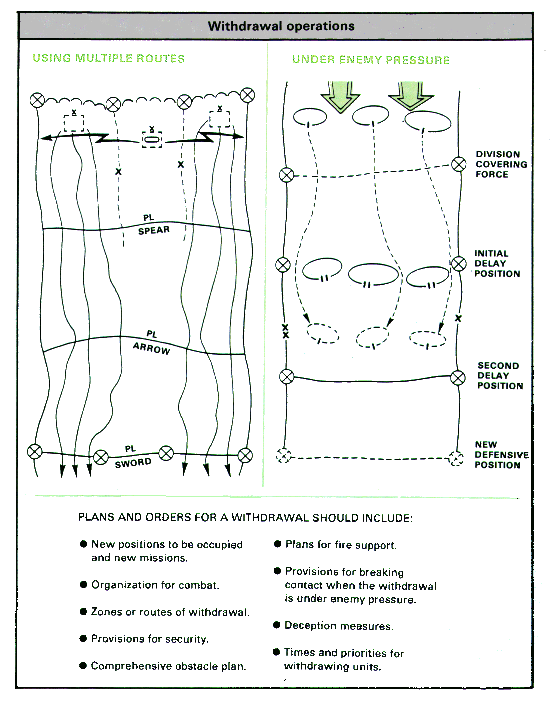
Reserves deploy well forward to assist withdrawing units by fire or ground attack. While units are withdrawing under pressure, reserves can launch spoiling attacks to disorganize, disrupt, and delay the enemy. Reserves may also cover the withdrawal or extricate encircled or heavily engaged forces. Army aviation units secure flanks, delay enemy armor, maintain command and control, and transport troops and materiel.
A retirement is a rearward movement by a force not in contact with the enemy. It is administrative in nature and execution, but commanders should have contingency plans if there is any chance of a meeting engagement.
The use of obstacles in retrograde operations varies widely depending upon the nature of the operation. In the delay, planning and executing obstacles is much the same as in the defense. At the other end of the scale, obstacles will rarely be employed to support retirements, except for those that are part of denial operations. Obstacle use in the withdrawal falls between these extremes.
Obstacles are used in both the defense and retrograde, but some significant differences are:
These considerations lead to emphasis upon reinforcing obstacles that can be emplaced and executed rapidly, and offer the greatest delay effect for the preparation effort such as bridge demolitions, point obstacles (including point minefield), and scatterable mines. In the delay, obstacles are used primarily to enhance antiarmor direct fire weapons. They also are placed in depth to assist delaying forces in breaking contact.
The delay provided by the second set of obstacles is vital if our forces are to succeed in breaking away to move to the next delay positions. In the withdrawal, obstacles are placed to slow the enemy's pursuit and disrupt his plans, and also to assist friendly forces in avoiding decisive engagement.
Because the attacker seeks rapidity of movement, he will attempt to use the road net. The first priority for obstacles is to those that block key avenues of approach, especially at major choke points (including bridges) and sites suitable for hasty river crossings. The next consideration is developing obstacles directly assisting planned withdrawals to successive delay positions, generally along the delay positions.
Because uncertainty is a large factor in the retrograde, obstacles that assist in preventing surprise to the friendly force are important. They give the delay force commander time to shift fires and move reserves to threatened areas. Special attention must be paid to obstacles that cover the flanks, and to lightly-held areas to counter the Threat doctrine of outdistancing and enveloping withdrawing forces. Potential airlanding or air drop zones also rate special attention in planning obstacles. Because the enemy can readily identify key choke points from maps, nearby landing or drop zone sites are especially important, and are best covered by planned scatterable mines.
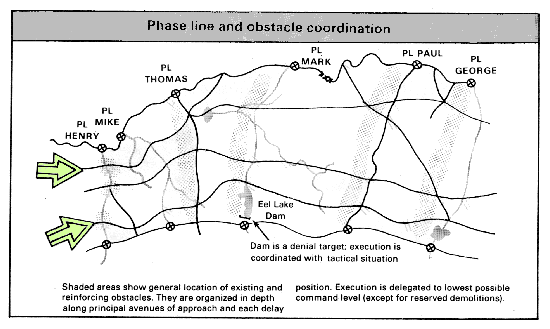
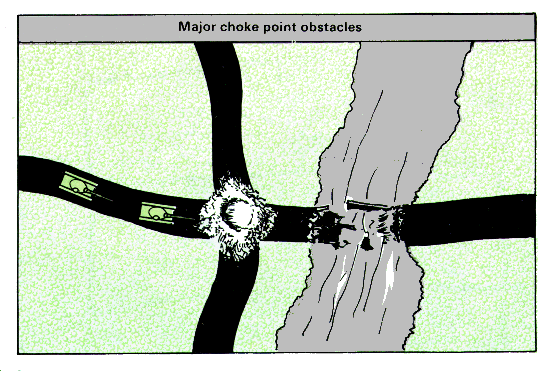
In retrograde operations, engineers normally accompany all units. Security forces normally have engineers attached. The basic load of obstacle materials carried by engineers will provide a limited capability to create obstacles. In addition, the retrograde facilitates stockpiling of obstacle materiel to support rapid placement of planned obstacles.
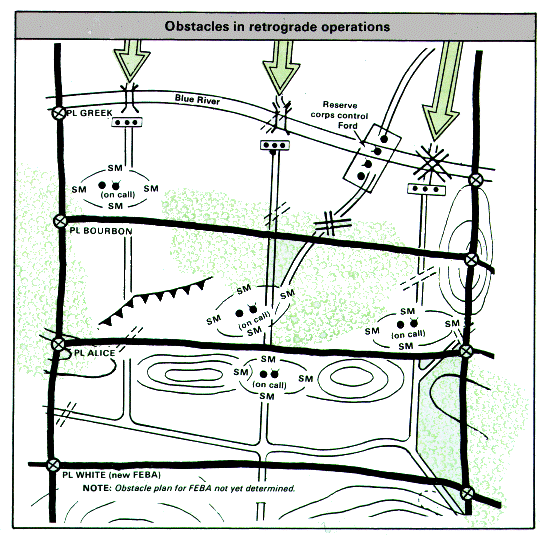
Distributing engineer units throughout the force also places counterobstacle equipment and facilities where they will be able to immediately breach interdictory obstacles (those the attacker might place behind withdrawing forces).
To the maximum extent possible, obstacles are sited to enhance the kill probabilities of antitank weapons. However, if necessary, the general principle that obstacles must be covered by direct fire or observed indirect fire can be relaxed in retrograde operations. Remote electronic sensors or other devices can be used to trigger planned artillery fire or mines, and make breaching very costly if observed fire is not possible.
In retrograde operations, obstacle planning must be done in as much detail as time will allow, but execution is closely controlled to assure that the effort is invested where it is most needed as the situation develops. Scatterable mines are particularly well-suited for use in retrograde operations because they can be placed where, when, and as needed. Their use is carefully planned to reduce delivery time. Planned sites include choke points not readily closed by demolitions, likely routes of advance, areas suitable for enemy artillery positions, likely landing or drop zones, and river crossing sites. Where availability of force permits, selected engineer units can be specially trained, reinforced, and employed under centralized control to emplace obstacles rapidly after the enemy's main effort is identified, or to respond to sudden changes in the situation.
Common in the retrograde, reserved demolitions must be tightly controlled by the lowest commander responsible for all units involved in passage of the obstacle. Other critical demolitions, such as bridges, should be executed as soon as prepared to preclude the possibility of capture and the requirement for demolition guards.
Deception is important in all retrograde operations and critical to withdrawal. Friendly forces must keep the attacker confused--uncertain of our plans and the location and disposition of our forces. Obstacles must be so planned that their execution will not inadvertently reveal friendly plans or positions. Concealed obstacles, use of dummy obstacles, and varied, expedient obstacles will assist in deception. Obstacle emplacement will frequently have to be carried out at night and under cover of smoke.
Denial targets are common in retrograde operations. In addition to those assigned by higher headquarters, division and brigade will frequently wish to add to their own "tactical" denial targets, such as those designed to destroy the usefulness of the road net. Disabled equipment and supplies, or other materials that cannot be evacuated, will also have to be destroyed.
Coordinating obstacle planning and preparation takes on the greatest importance in retrograde operations. Corps or theater army engineer units may be tasked to construct positions and obstacle systems well to the rear of the forces who will eventually fight there. In this instance, coordination arrangements between the preparing and final using units becomes vital.
Planning considerations
Mission.
Directed and reserve obstacles.
Future plans.
Enemy strengths and weaknesses.
Terrain and weather.
Available resources.
Effects on local population.
Obstacles should support weapon systems, not impede future mobility, support movement from battle position to battle position, and be placed in depth.
Retrograde operations
Retrograde operations include the delay (to trade space for time), the withdrawal (to disengage from enemy contact), and the retirement (to move away without contact).
Retrograde operations are planned by corps and division, but may be carried out by brigade. They feature centralized planning and decentralized execution.
Threat forces seek to penetrate, bypass, and cut off friendly forces in the retrograde.
The best possible use must be made of existing obstacles; reinforcing obstacles must offer the best return for the effort invested.
Obstacles priorities are to key choke points, delay positions (with priority to the most forward delay position), and flanks. Among positions, priority is always to the initial delay position.
In the delay, obstacles assist in inflicting losses and breaking contact. In the withdrawal, obstacles assist in slowing the attacker, disrupting his plans, and avoiding decisive engagement. In the retirement, obstacles may be planned for security.
Scatterable mines are ideal for retrograde use.
Careful planning and tight control of reserved demolitions is necessary to preclude premature demolition or capture by the enemy before detonation.